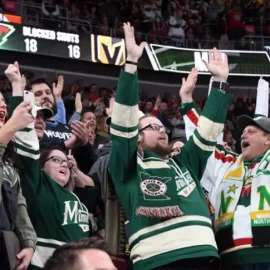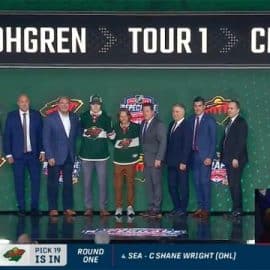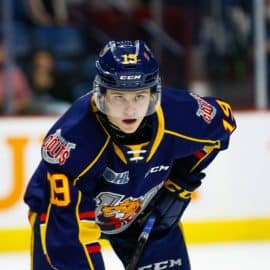Watching the Olympics as I am right now, I have to admit I’ve grown to hate the spoilers. Yet they’re almost unavoidable especially in an Olympics that is more or less completely broadcast via tape delay. Comedy Central‘s Jon Stewart provided a hilarious take on the poorly executed ‘spoiler warnings’ of major news outlets where they attempt to be helpful only to fail miserably at allowing the viewers to actually avoid seeing the results of the various competitions. You can see Stewart’s take on these ineffective ‘spoiler alerts’ here. However, with social media. Particularly Facebook and Twitter, avoiding seeing the results from the Olympics is almost impossible. These two outlets are the perfect example of a society’s want for ‘access’ and professional sports has been forced to try to cater to this insatiable need for fans to see what is going on behind the scenes. Perhaps inspired by the Edmonton Oilers’ popular series ‘Oil Change‘ the Minnesota Wild began their own informative behind the scenes series called Becoming Wild last summer. The 6-part series shown on Fox Sports Net North last year had 30-minute episodes that tried to promote the potential and progress for the Wild’s young players as covering personnel changes both in players and the team’s head coach Mike Yeo.
Just like ‘Oil Change‘ which hopes to capture that moment when their team turns its respective fortunes around the Minnesota Wild brought back Becoming Wild for another year. Instead of the 30-minute episodes broadcast on FSN, this year’s edition has been in the form of webisodes hosted by wild.com. We will try to provide a brief summary of our take aways from the various webisodes to foster discussion and we would love to hear your thoughts on the webisodes too. What do you like and what else do wish you could see?
Click on “Read More” for the rest of the article…
Webisode summary: Sadly, Wild fans who were anticipating the start of Becoming Wild, they were going to find themselves disappointed. Episode 1, was simply a rehash of events from last year’s series and a bit of introduction to this year’s series. I’ll admit I was extremely disappointed by ths first episode. I expected more, and I felt like I got nothing more than a review and a preview. To me, it reminds me of when I watch the NBC Nightly News, in that before they get to the stories in-depth, you get a preview of what will be on the news that night. I’m also disappointed that this year’s series is nothing but a bunch of five or so minute webisodes. I much preferred last year’s 30-minute episodes on television. I found them to be far more informative, not to mention, entertaining.
Becoming Wild – Webisode #2
Webisode summary: Episode 2, is definitely an improvement over Episode 1. We see the start of the Wild’s prospect camp. The main focus of this look at prospect camp was physical training and skating, and in particular, power skating. The prospects spent considerable time with the Wild’s strength and conditioning coach, Kirk Olson. Olson points out that the physical test they’re going to take isn’t just weight lifting. I think there are times that many young athletes in all sports when they hear the words “strength and conditioning” immediately think of lifting weights. While gaining strength through lifting weights is extremely important, there are many more facets to getting stronger. If you’re extremely strong, but then have limited endurance or poor form and balance, then all of that strength will do you little good. After we see the prospects in the weight room going through their paces, we see them take the ice for a skating lesson with Barry Karn. As Karn says, he’s having them work on things, that they may have never done before when it comes to hockey. I don’t know about you, but that made me stop and think. Yes, the players are essentially still rough around the edges, but several of them are highly touted prospects. It’s comments like that by Karn that remind us how much further they need to come before they’re a true NHL player. And like Mike Yeo said, “if you can’t skate, you can’t play.” Hopefully those words sink in, because we’ve had times over the years where skating and speed have been issues for Minnesota.
Webisode summary: Episode 3 gave us a glimpse into the classroom aspect that happens at the Wild’s Summer Development (Prospect) camp. Not all of their training and evaluation happens on the ice or in the weight room. There are mental and other physical elements that are extremely important to prospects and veteran players alike. We are introduced to Seetha DeMarco from Elite Management Training. In her presentation to the prospects, she dealt with the importance of health and nutrition. As mentioned in this episode, there are new studies out there on the number of hours various people need to sleep. For the most part, we’ve heard the stories on the news about how middle school students need to get eight or more hours of sleep a night. For athletes, especially those in the high-stress field of professional sports, studies are showing they need ten or more hours of sleep. That of course is hard to come by during the season, especially on the lengthy road trip. Now perhaps more of us can understand just how important that afternoon, pre-game nap is for the players. DeMarco obviously stated that everything that she talked about was individually specific and that her talk was just general information. While the information was important, personally I didn’t like her delivery style. DeMarco reminded me of the kind of person who was an elementary teacher for a couple of years and decided he or she could make more money being something more like a life coach. At times she came off as condescending, and it’s my hope that the players were just too tired after a good practice that they didn’t notice. However, it appears that several of the players came out of the talk with some good information, and that no one can be bothered by.
Webisode summary: Probably one of the most important parts of hockey, stick handling, is addressed in Episode 4. While this is something that hockey players of all ages work on their entire careers, there’s something almost child-like, watching a bunch of teenagers and twenty-somethings working on their hands using a golf ball and their hockey stick. It’s such a basic skill, that perhaps the intense work on their stick handling took them back to their respective childhoods that it came off as somewhat child-like to me. Personally I like that, because even though several of the prospects will become legitimate professional players, they need to remember at the heart of everything, they are playing a game. I don’t know about you, but the last I looked, games were supposed to be fun. The sessions on stick handling were taught/coached by Andy Ness. Young players like Nick Seeler stated that you can always work on your stick work. Probably the most important thing pointed out by Ness is that passing (both giving and receiving the pass) is much harder with the new graphite composite sticks. The new sticks just don’t absorb the puck like the old wood or even wood and aluminum sticks did. With that in mind, since the graphite composites appear to be here for good, passing and other stick handling drills will constantly need to be worked on, even by veterans.
Webisode summary: This is probably one of the more fun episodes in the series (and was for last year as well). During prospect camp, the Wild loads all 45 prospect camp participants on buses and takes them out to play paintball. While it’s fun and allows you to vent some frustrations against people that may have built up on the ice, it’s also another form of team building. Players pick their teams, plan strategies (while not always within the rules), and then engage the other team. In our own jobs, our bosses and supervisors sometimes put together fun events for employees. While sometimes they’re more social in nature, even those social events can go a long way to help the “team” as a whole. In my daytime job in customer service, I need to know that my fellow co-workers are going to help our customers as much as I do. Being able to talk with those co-workers in a fun environment while not on the phones helping customers, certainly goes a long way in strengthening the team. The paintball experience for these young aspiring professional hockey players accomplishes the same thing for them. I don’t want to give too much away (well if you haven’t watched these yet), but the comments from the players are pretty funny. Because of those comments, you know that they’re having fun. Hopefully events like this can help them bring fun back into their jobs on the ice.
Webisode summary: This episode is pretty much a wrap up of the prospect camp by none other than Wild General Manager, Chuck Fletcher. What was really nice about this wrap is that Fletcher gave fans a nice explanation of what he and the rest of the front office staff saw during the week of nine of the Wild’s prospects. Of course he talked about Mikael Granlund and Matthew Dumba, but it was nice to see him talk about less thought of prospects like Erik Haula and Brett Bulmer. While Fletcher never really shows too many of his emotions, you get the feeling from this episode that he is truly excited about the future of the Minnesota Wild, and that future clearly includes the young players coming up through the ranks.
Webisode summary: If you needed a feel good story for the summer, this episode (and Episode 8) are for you. The focus on Episode 7, was on that fantastic non-profit organization, Defending the Blue Line. While the organization has spread to states outside of Minnesota, it’s nice to know that it was started in Minnesota by a group of Minnesota National Guard members. If you somehow are still unaware of what this group does, they raise funds to help provide equipment, pay hockey fees and camp tuition, as well as trips to see NHL games to the kids of members of the military. In this episode, we get to see parts of a charity game played by current and former NHL players as well as what appears to be an on-ice mini-camp for young players. In that mini-camp, Elk River, MN-native, Nate Prosser was on the ice with the kids. If you’re looking for a charitable organization to give a donation to or to volunteer with, Defending the Blue Line, please consider this first-rate group. With more and more families, especially military families, struggling to pay for just their basic day-to-day living expenses, it’s nice to see groups help our military families bring a bit of fun and normalcy to children during the stressful times that come with deployment.
Webisode summary: Yes, here is the second feel-good story of this year’s Becoming Wild series. And it too involves another fantastic charitable organization that involves hockey and kids. This group was founded by Wild player Matt Cullen. The organization, Cullen Children’s Foundation or more affectionately known as Cully’s Kids, raises money for children’s healthcare especially for kids who have cancer. Matt and his wife were inspired by events both within their family as well as while Matt was in Italy during the NHL lockout. First, Matt’s brother Mark Cullen had a malignant mole removed in 2003. While in Italy, they met a young boy who had cancer. Those experiences and a desire to help others inspired them to start this charity. The main event is a three-day weekend in July known as the Cully’s Kids Celebrity Weekend. First off is the silent auction on Thursday, then the golf tournament on Friday. While those are all well and good, and raise a lot of money, it is the Saturday event that is the heart of the Cullen’s organization. It is simply an event for kids. It is that picnic for those sick children that helps remind us adults what is the most important part of the Cullen Children’s Foundation. Through various fundraising efforts, the Cullen Children’s Foundation was recently able to donate $1 million dollars to Sanford Health Foundation in Fargo, ND in order to build a state of the art play area for children at their children’s hospital. Just like it’s important for all of us to find fun in our day-to-day lives, it is even more important for sick children. This donation will simply be able to turn that dream into a reality. This too is another fantastic group to donate to if you’re able to help kids, especially those in our backyard who need some help being able to be a kid.
Webisode summary: While Becoming Wild focuses on Wild prospects (and rightfully so), it is also nice to catch a glimpse at what the veteran players are doing during the off-season. Like the narration says, in this era of professional hockey, there really is no “off” in off-season. Players are still training in one form or another. I think this is important for young players to see, especially those who perhaps can’t afford summer ice time, hockey camps or a gym membership. Some players have a simple weight system at home. Others are out running stairs. Some do a lot of bicycle riding. Even if you don’t have access, you can still train and work out. Also, in this day and age of young athletes focusing on one sport (some even while they’re still in junior high), they need to do workouts that are varied and work different muscle groups or work the same muscle groups but in different ways. Going mountain biking works on endurance as well as one’s leg muscles. Same with running stairs. Of course we all know that these professional players spend quite a bit of time on the ice as well during the off-season, it’s also nice seeing them doing workouts that are away from the ice. It might give some of us some ideas of different ways we can perhaps train ‘like the pro’s do’ in our own communities.
Still want more access? Why not follow your favorite Wild players / prospects via Twitter? I admit I follow some of them but not all but here is your one stop shop for all of their Twitter addresses. All of these are the real deal, don’t be fooled by imitators! Please remember you can follow us on Twitter as well @StateofHckyNews too!
Justin Falk – @JuicerFalk
Matt Kassian – @Kassassination
Brett Bulmer – @BrettBulmer92
Charlie Coyle – @CharlieCoyle_3
Tyler Cuma – @TCuma61
Justin Fontaine – @J_Fontaine37
Chay Genoway – @chaygenoway
Devin Setoguchi – @Dsetoguchi10
Steven Kampfer – @StevenKampfer47
Darcy Kuemper – @dkuemps35
Zack Phillips – @zackphillips7
Jason Zucker – @Jason_Zucker16
Matt Hackett – @MattHackett31
David McIntyre – @DaveJMcIntyre
Erik Haula – @EHaula
Don’t forget these other people very close to the Wild organization too!
Wes Walz – @walz3737
Tom Reid – @tomreid20
Kevin Falness – @RadioFalness
Kevin Gorg – @HockeyHorse21
Tony DaCosta – @styleswild
Rick Bronwell – @RickBronwell
Add The Sports Daily to your Google News Feed!










